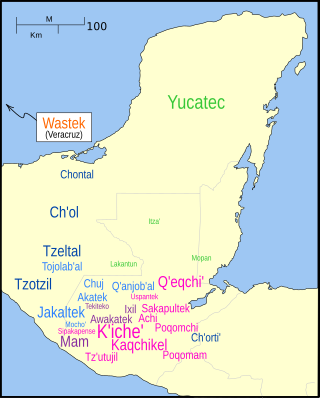An infix is an affix inserted inside a word stem. It contrasts with adfix, a rare term for an affix attached to the outside of a stem, such as a prefix or suffix.
Old Javanese or Kawi is the oldest attested phase of the Javanese language. It was spoken in the eastern part of what is now Central Java and the whole of East Java, Indonesia. As a literary language, Kawi was used across Java and on the islands of Madura, Bali and Lombok. It had a sizable vocabulary of Sanskrit loanwords but had not yet developed the formal krama language register, to be used with one's social superiors that is characteristic of modern Javanese.
Brithenig, or also known as Comroig, is an invented language, or constructed language ("conlang"). It was created as a hobby in 1996 by Andrew Smith from New Zealand, who also invented the alternate history of Ill Bethisad to "explain" it. Officially according to the Ill Bethisad Wiki, Brithenig is classified as a Britanno-Romance language, along with other Romance languages that displaced Celtic.
Hurrian is an extinct Hurro-Urartian language spoken by the Hurrians (Khurrites), a people who entered northern Mesopotamia around 2300 BC and had mostly vanished by 1000 BC. Hurrian was the language of the Mitanni kingdom in northern Mesopotamia and was likely spoken at least initially in Hurrian settlements in modern-day Syria.
Tagalog grammar is the body of rules that describe the structure of expressions in the Tagalog language, the language of the Tagalog region of the Philippines.

Tzeltal or Tseltal is a Mayan language spoken in the Mexican state of Chiapas, mostly in the municipalities of Ocosingo, Altamirano, Huixtán, Tenejapa, Yajalón, Chanal, Sitalá, Amatenango del Valle, Socoltenango, Las Rosas, Chilón, San Juan Cancuc, San Cristóbal de las Casas and Oxchuc. Tzeltal is one of many Mayan languages spoken near this eastern region of Chiapas, including Tzotzil, Chʼol, and Tojolabʼal, among others. There is also a small Tzeltal diaspora in other parts of Mexico and the United States, primarily as a result of unfavorable economic conditions in Chiapas.
Georgian grammar has many distinctive and extremely complex features, such as split ergativity and a polypersonal verb agreement system.
Middle Welsh is the label attached to the Welsh language of the 12th to 15th centuries, of which much more remains than for any earlier period. This form of Welsh developed directly from Old Welsh.

Hindustani, the lingua franca of Northern India and Pakistan, has two standardised registers: Hindi and Urdu. Grammatical differences between the two standards are minor but each uses its own script: Hindi uses Devanagari while Urdu uses an extended form of the Perso-Arabic script, typically in the Nastaʿlīq style.
Paumarí is an Arauan language spoken in Brazil by about 300 older adults out of an ethnic population of 900. It is spoken by the Paumari Indians, who call their language “Pamoari”. The word “Pamoari” has several different meanings in the Paumarí language: ‘man,’ ‘people,’ ‘human being,’ and ‘client.’ These multiple meanings stem from their different relationships with outsiders; presumably it means ‘human being’ when they refer to themselves to someone of ostensibly equal status, and ‘client’ when referring to their people among river traders and Portuguese speakers.
Tsimshian, known by its speakers as Sm'álgyax, is a dialect of the Tsimshian language spoken in northwestern British Columbia and southeastern Alaska. Sm'algyax means literally "real or true language."
Kurdish grammar has many inflections, with prefixes and suffixes added to roots to express grammatical relations and to form words.
This article presents a brief overview of the grammar of the Sesotho and provides links to more detailed articles.
The grammar of the Marathi language shares similarities with other modern Indo-Aryan languages such as Odia, Gujarati or Punjabi. The first modern book exclusively about the grammar of Marathi was printed in 1805 by Willam Carey.

The Nukak language is a language of uncertain classification, perhaps part of the macrofamily Puinave-Maku. It is very closely related to Kakwa.
Cebuano grammar encompasses the rules that define the Cebuano language, the most widely spoken of all the languages in the Visayan Group of languages, spoken in Cebu, Bohol, Siquijor, part of Leyte island, part of Samar island, Negros Oriental, especially in Dumaguete, and the majority of cities and provinces of Mindanao.

In linguistic morphology, inflection is a process of word formation in which a word is modified to express different grammatical categories such as tense, case, voice, aspect, person, number, gender, mood, animacy, and definiteness. The inflection of verbs is called conjugation, and one can refer to the inflection of nouns, adjectives, adverbs, pronouns, determiners, participles, prepositions and postpositions, numerals, articles, etc, as declension.
The Naʼvi language is a fictional constructed language originally made for the 2009 film Avatar. In the film franchise, the language is spoken by the Naʼvi, a race of sapient humanoids indigenous to the extraterrestrial moon Pandora. The language was created by Paul Frommer, a professor at the USC Marshall School of Business with a doctorate in linguistics. Naʼvi was designed to fit moviemaker James Cameron's conception of what the language should sound like in the film. It had to be realistically learnable by the fictional human characters of the film and pronounceable by the actors, but also not closely resemble any single human language.
Kédang is a language spoken in the Kedang region on the north coast of Lembata Island, east of Flores, in Indonesia. The language belongs to the Austronesian family and its sub-family, Malayo-Polynesian. More specifically, the language is within the Flores-Lembata sub-group. There are approximately 30,000 speakers of the language.
This article describes the grammar of the Old Irish language. The grammar of the language has been described with exhaustive detail by various authors, including Thurneysen, Binchy and Bergin, McCone, O'Connell, Stifter, among many others.



